Uncover the unexpected role of beds in biblical narratives, from dreams of divine ladders to miraculous healings, and the profound meanings they hold.
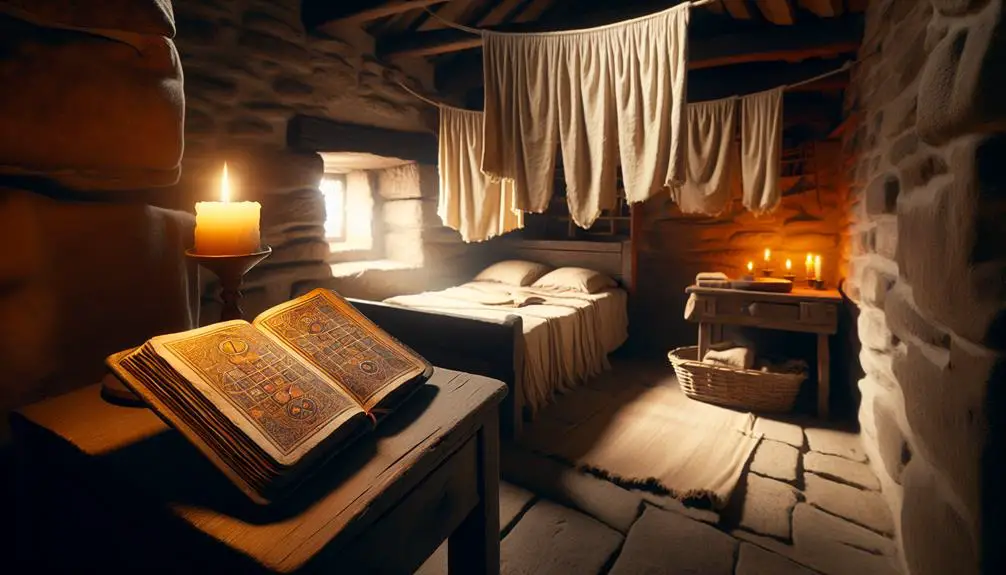
Bed in the Bible
Interestingly, you might not have expected to find that beds play a significant role throughout the Bible, yet they weave into some of its most profound narratives. From Jacob's dream that revealed a ladder reaching to heaven as he slept on a stone, to the healing miracles performed on them, beds symbolize moments of vulnerability, revelation, and divine intervention.
As you explore these stories, from Genesis to the Acts of the Apostles, you'll uncover layers of meaning that challenge the simplicity of a bed's function, inviting you to ponder the deeper connections between rest, healing, and prophecy in biblical times. What might these stories reveal about the nature of comfort, safety, and divine communication?
Key Takeaways
- Beds in biblical narratives often symbolize rest, healing, and divine encounters, as seen in Jacob's Dream.
- The healing of the paralytic on a bed demonstrates Jesus's authority to forgive sins and restore physical and spiritual well-being.
- Beds may reflect societal status and craftsmanship, akin to Solomon's lavish furnishings, symbolizing prosperity and divine favor.
- Human reactions to divine actions involving beds, such as healing, reveal varied societal attitudes and deepen understanding of biblical contexts.
Genesis: Jacob's Dream

In the book of Genesis, Jacob's dream introduces a pivotal moment where a celestial ladder connects Earth to heaven, symbolizing divine presence and guidance. This narrative, rich in metaphors, invites you to delve deeper into the theological implications of ladder symbolism within the context of biblical history. The ladder not only serves as a bridge between the divine and the mundane but also as a visual representation of God's accessibility to humanity.
Analyzing this passage, you'll find that the ladder's symbolic function is multifaceted. It represents the possibility of direct communication with the divine, an idea that was revolutionary in the ancient religious landscape. The dream suggests that divine presence isn't confined to a sacred temple or a select few; rather, it's accessible to all, including a solitary traveler like Jacob, resting in a desolate place.
Furthermore, the angels ascending and descending upon it underscore the continuous interaction between heaven and Earth. This isn't a one-time event but an ongoing relationship, symbolizing God's unwavering commitment to guide and protect His people. The ladder, thus, becomes a symbol of hope and reassurance, emphasizing that divine presence is always within reach, guiding human endeavors.
Healing of the Paralytic
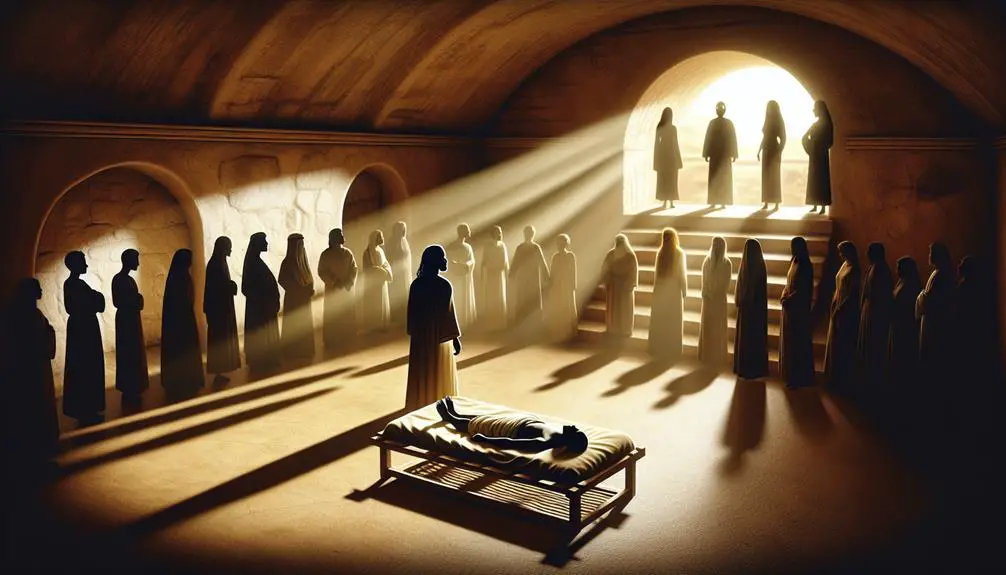
You must consider the symbolic meaning behind the miracle of the Healing of the Paralytic, as it's crucial for understanding deeper theological implications.
Observing the varied reactions of the witnesses provides insight into the societal and religious context of the time.
This analysis will help you appreciate the complexity and multifaceted nature of this biblical event.
Miracle's Symbolic Meaning
The healing of the paralytic, as recounted in the Bible, serves as a profound symbol of Jesus's power to forgive sins and restore physical and spiritual wholeness.
Dream Interpretation |
Symbolic Restoration |
|---|---|
Physical Healing |
The act of healing the paralytic directly symbolizes Jesus's authority over physical ailments, showcasing divine intervention bridging the gap between human limitation and spiritual transcendence. |
Forgiveness of Sins |
This miracle underscores the belief in Jesus's unique ability to forgive sins, a cornerstone of Christian faith emphasizing spiritual renewal. |
Faith's Role |
The faith of those who brought the paralytic to Jesus highlights the collective responsibility in seeking divine healing and restoration. |
Community Restoration |
Beyond the individual's healing, this miracle illustrates the restoration of community ties, reinforcing the interconnectedness of societal and spiritual health. |
This analysis underscores the layered meanings behind the miracle, emphasizing dream interpretation and symbolic restoration as key aspects of its significance.
Witnesses' Varied Reactions
Observing the healing of the paralytic, witnesses displayed a spectrum of reactions, from awe to skepticism, shaping a complex tableau of human response to divine intervention. This variance in response holds cultural significance, as it mirrors the broader societal attitudes towards miracles and divine acts within the historical context.
Archaeological evidence, while not directly capturing these reactions, offers insights into the physical settings where such miracles were purported to occur, indirectly shedding light on the potential diversity of witness reactions. Through methodical analysis of both textual descriptions and archaeological findings, one can infer the multifaceted nature of human responses to miraculous events, highlighting the interplay between faith, doubt, and the quest for understanding within a cultural and historical framework.
King David's Final Days

Approaching the end of his life, King David's final days were marked by a blend of political maneuvering and personal reflection, illustrating the complexities of his reign and legacy. You'll find that these moments not only shaped the immediate future of the Israelite kingdom through David's succession but also set precedents for royal mourning and the transfer of power in ancient times.
To understand the significance of this period, consider the following aspects:
- The strategic selection of Solomon as his successor: David's decision underscored the importance of divine guidance and political acumen in ensuring a smooth transition of power.
- The detailed instructions given to Solomon: These not only included governance advice but also directives for dealing with David's adversaries, highlighting the blend of wisdom and pragmatism that characterized David's rule.
- The public and personal nature of royal mourning: David's final days were enveloped in an atmosphere of anticipation mixed with reverence, setting a template for how royal deaths were to be publicly mourned and commemorated.
- The implications for the Davidic legacy: David's actions in his final days were pivotal in solidifying his legacy, influencing the theological and royal narratives within the biblical texts.
Analyzing these elements, you'll gain a deeper appreciation for the intricate dynamics at play during the twilight of David's reign. The careful orchestration of David's succession and the solemnity of royal mourning reflect a leader who remained methodical and strategic, even as he faced the inevitability of his own mortality.
Solomon's Lavish Furnishings
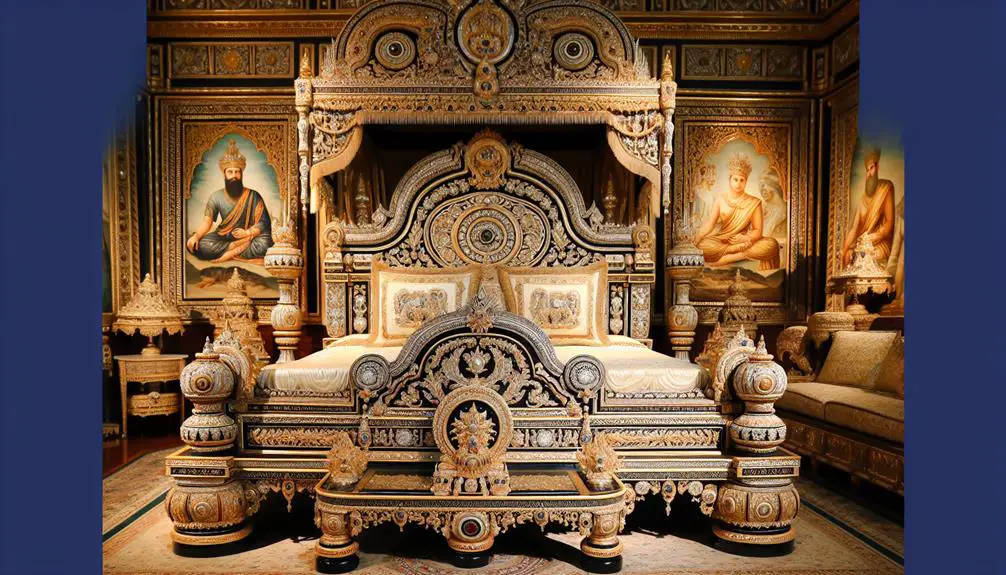
ARTICLE TITLE: Bed in the Bible
PREVIOUS SUBTOPIC: 'King David's Final Days'
CURRENT SUBTOPIC: 'Solomon's Lavish Furnishings'
Following King David's strategic planning for his succession, Solomon's reign commenced with an emphasis on grandeur, as evidenced by his decision to invest in lavish furnishings for the temple and his palace. Solomon's wisdom wasn't just evident in his governance and judicial decisions; it also shone through in his approach to the temple construction, where he spared no expense to ensure that the temple and his own living quarters reflected divine magnificence and royal dignity.
Feature |
Description |
|---|---|
Materials Used |
Gold, cedar wood, and precious stones were predominantly used. |
Craftsmanship |
Artisans from Tyre, skilled in intricate designs, were employed. |
Thematic Elements |
Cherubim, palm trees, and open flowers symbolizing fertility and life. |
Technological Feat |
The use of cast metal work in the temple was unprecedented. |
Cultural Significance |
Reflecting Solomon's wisdom and Israel's prosperity under his reign. |
This analytical examination reveals that the opulence of Solomon's furnishings was not merely a display of wealth but a methodical effort to manifest the spiritual and cultural zenith Israel had reached. The temple construction, in particular, showcased Solomon's dedication to honoring his father David's vision and God's commandments, ensuring that the place of worship stood as a testament to divine glory and Israelite craftsmanship. Solomon's wise administration of resources facilitated this monumental achievement, setting a standard for future generations.
Elisha Raises the Shunammite's Son

In the narrative of Elisha raising the Shunammite's son, we encounter a profound demonstration of faith and divine intervention, marking a pivotal moment in the biblical account of miracles. This story illustrates not only the power of God through His prophet Elisha but also underscores the virtues of hospitality rewarded and maternal faith.
The tale begins with the Shunammite woman's generous hospitality towards Elisha, providing him with a bed and necessities whenever he passed through Shunem. Her kindness didn't go unnoticed, and in return, she was promised a son, despite her husband's old age. When the child suddenly died, her faith didn't waver; instead, she sought Elisha, believing in the possibility of a miracle.
To deepen your understanding, consider the following points:
- The bed, symbolizing the Shunammite's hospitality, becomes a central element in the unfolding of the miracle.
- Elisha's response to the Shunammite woman's plight exemplifies the prophet's role as God's instrument, channeling divine power.
- The act of Elisha lying on the child and the subsequent resurrection spotlight the intimate, personal nature of biblical miracles.
- The Shunammite woman's unwavering faith in Elisha and, by extension, in God, serves as a testament to the strength of maternal faith.
Analyzing this story through a scholarly lens, we observe a multifaceted narrative that intertwines human virtue with divine action. Hospitality rewarded with a miraculous return, and maternal faith confronting the despair of loss, highlight the complex interplay between divine providence and human agency in the biblical tradition.
Esther's Courageous Request
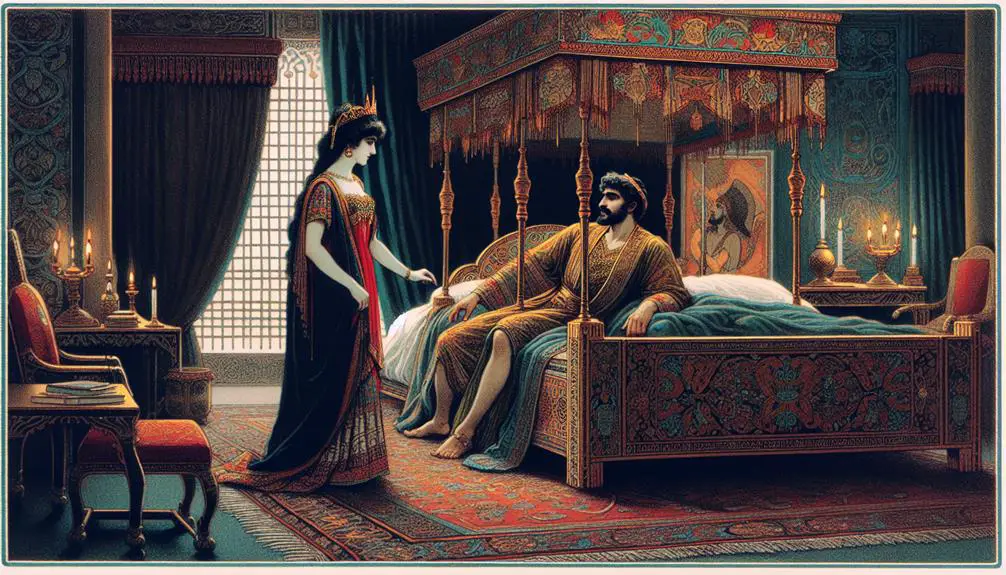
Shifting focus to another profound narrative, we examine Esther's courageous request, a story that underscores the complexity of faith, risk, and divine orchestration in biblical texts. You'll find that within the context of the Persian empire, the setting of a royal banquet isn't merely a backdrop for opulence but a pivotal stage for divine intervention and human agency. Esther, a Jewish queen hidden within the Persian empire's royal echelons, faces a momentous decision that could very well end her life or save her people.
You see, Esther's request isn't made in the safety of anonymity but in the highly charged atmosphere of a royal banquet attended by the king himself and his courtiers. This setting amplifies the risk, as Esther must breach protocol in a society where such actions could lead to immediate execution. Her approach to the king, under such circumstances, is a testament to her faith and the divine orchestration at play. The banquet becomes a fulcrum, balancing the imminent danger against the potential for great deliverance.
Analyzing this narrative, you discern a methodical unfolding of events where Esther's courage, coupled with strategic timing, plays a critical role. The royal banquet, often a symbol of the Persian empire's might and opulence, is transformed into a setting of vulnerability and divine possibility. Esther's request, made in such a perilous context, highlights the interplay between human courage and divine guidance, illustrating how faith can navigate the complexities of political power, risk, and the quest for justice.
The Parable of the Great Banquet
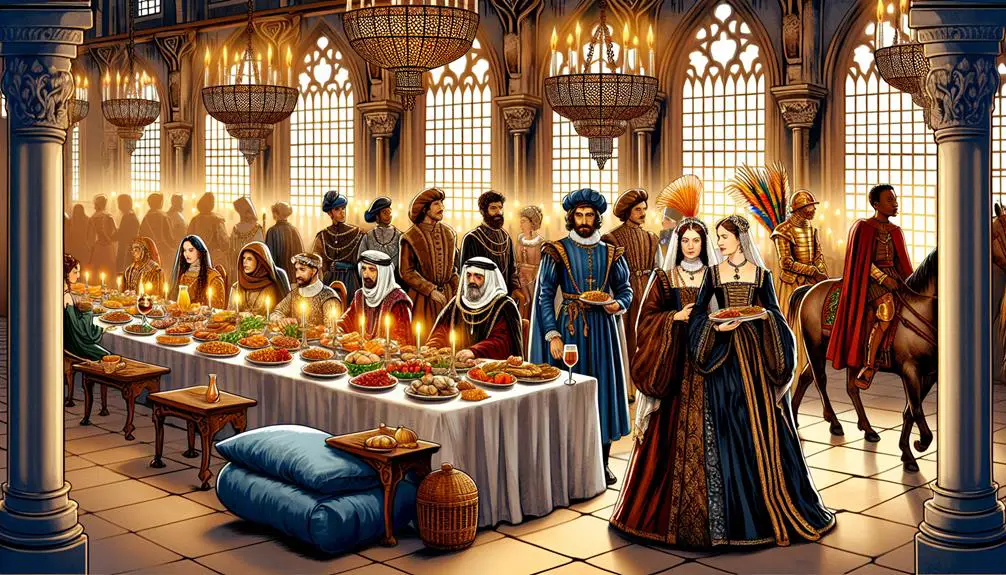
You'll find that the Parable of the Great Banquet explores the theme of invitation's universal scope, highlighting the inclusivity of the call to partake.
It's crucial to understand how the narrative underscores the varied responses elicited by this divine summons.
This analysis sets the stage to examine the implications of accepting or ignoring the invitation, reflecting on broader theological and moral questions.
Invitation's Universal Scope
The Parable of the Great Banquet, as narrated in the Gospel of Luke, extends a universal invitation, underscoring the inclusivity of God's kingdom. This narrative conveys a global invitation with an inclusive message, highlighting key aspects:
- Global Invitation: Emphasizes that everyone, irrespective of their societal status or background, is invited.
- Inclusive Message: Stresses that the kingdom of God is open to all who choose to accept the invitation.
- Societal Barriers: Illustrates the breaking down of traditional societal barriers, inviting the marginalized and overlooked.
- Unconditional Love: Showcases God's unconditional love and acceptance, inviting individuals to partake in the divine feast.
Analyzing this parable, one appreciates the depth of its message, encouraging reflection on the nature of divine inclusivity and the openness of the invitation to God's kingdom.
Response to the Call
Many respond to the divine invitation with a variety of excuses, revealing underlying attitudes towards the call to join the kingdom of God. This reflection on human behavior highlights the critical role of divine intervention in achieving spiritual awakening.
Analyzing these responses, one can discern a pattern of distraction and prioritization of earthly matters over spiritual callings. The excuses, symbolizing beds of comfort and security, suggest a reluctance to leave one's comfort zone for spiritual growth.
The parable serves as a methodical examination of human priorities in the face of divine invitation. It underscores the necessity of recognizing and responding to this call with openness, shedding light on the transformative power of spiritual awakening facilitated by divine intervention.
The Sick Healed at Peter's Shadow
In an extraordinary display of faith and divine power, people brought the sick into the streets, hoping that even Peter's shadow might fall on some of them and they'd be healed. This event isn't just a miraculous narrative; it's a profound study in the dynamics of shadow significance and Apostolic authority within the early Christian community. Here's a deeper look:
- Shadow significance: In cultural and biblical contexts, shadows often symbolize protection, presence, or influence. Peter's shadow becoming a source of healing underscores the profound impact of spiritual presence and the power vested in the Apostles.
- Apostolic authority: This incident illustrates the early Church's recognition of the Apostles' unique role as conduits of divine power. Their authority wasn't just in teaching but also in extraordinary acts that validated their message.
- Community faith: The community's action of bringing the sick onto the streets reflects a collective belief in the Apostles' ability to mediate divine healing. This demonstrates the integral role of communal faith in experiencing divine interventions.
- Divine endorsement: The miracles performed through Peter's shadow can be seen as a divine endorsement of his and the Apostolic mission, reassuring the early believers and attracting new ones.
Analyzing this event, one realizes that it's not merely about the physical healing but also about reinforcing the foundational pillars of the early Church: the Apostolic authority, the power of faith, and the direct involvement of the divine in the believers' lives. This narrative, therefore, serves as a multifaceted testament to the burgeoning faith and its manifestations in the nascent Christian community.
Frequently Asked Questions
How Has the Symbolism of Beds Evolved in Biblical Interpretations Through the Ages, Particularly in Non-Western Cultures?
You're exploring how the symbolism of beds has transformed over time, focusing on cultural interpretations and symbolic evolution, especially within non-western societies.
This involves delving into how beds, traditionally seen as places of rest and intimacy, have been reinterpreted through various lenses, reflecting shifts in societal values, religious beliefs, and cultural practices.
Your analysis is methodical, examining these changes to understand the broader implications on biblical interpretations and cultural narratives.
In What Way Did the Concept of a Bed as a Place of Rest Contrast With Its Use as a Place for Significant Visions or Divine Encounters in Biblical Times?
In biblical times, your bed wasn't just your sleep station; it was also a hotspot for divine Wi-Fi, connecting you to God through dreams. This dual role highlights a stark contrast: while sleep symbolizes rest and renewal, dream interpretations often reveal significant visions or divine encounters.
Analyzing this dichotomy offers insight into the multifaceted nature of beds, intertwining physical rest with spiritual awakening and guidance in a profound, methodical exploration.
Are There Any Documented Changes in the Design and Materials of Beds From the Periods Described in the Bible Compared to Those Used in Contemporary Middle Eastern Societies?
You're exploring how the design and materials of beds have evolved from ancient times to modern Middle Eastern societies. Specifically, you're delving into sleeping postures and construction techniques.
Analyzing this progression, you'll find significant changes in materials used and the methods of constructing beds. These advancements reflect cultural shifts and technological progress.
It's essential to understand these changes to appreciate how sleeping arrangements have adapted over centuries, impacting rest and societal norms.
How Do Biblical References to Beds Influence Modern Christian Practices or Theological Concepts Surrounding Rest, Healing, or Hospitality?
You're exploring how biblical mentions of beds shape contemporary Christian views on rest, healing, and hospitality. This inquiry delves into the symbolic and literal interpretations of beds in biblical texts, analyzing their impact on modern Christian practices.
Can Parallels Be Drawn Between the Narrative Significance of Beds in the Bible and Their Portrayal in Other Ancient Religious Texts or Mythologies?
Absolutely, you can draw parallels. Imagine beds as stages where myths and divine whispers converge.
In exploring mythical reclination and ritual sleep across cultures, one discovers beds aren't merely for rest. They're arenas for divine encounters, healing, and prophecy in many traditions.
This analytical journey reveals that beds, beyond their physical comfort, serve as crucibles for spiritual awakening and transformation, mirroring their narrative significance in ancient texts and mythologies.
Conclusion
In the tapestry of biblical narratives, the motif of the bed weaves a thread of profound significance. It's not merely a piece of furniture but a stage for divine encounters, healing miracles, and kingly transitions.
From Jacob's celestial visions to Esther's courageous appeal, beds symbolize pivotal moments of vulnerability and transformation. Analyzing these stories reveals how beds serve as vessels for God's intervention, illustrating the sacredness imbued in our moments of rest and transition.
Thus, the biblical bed transcends its physical form, embodying a nexus of spiritual revelation and human experience.


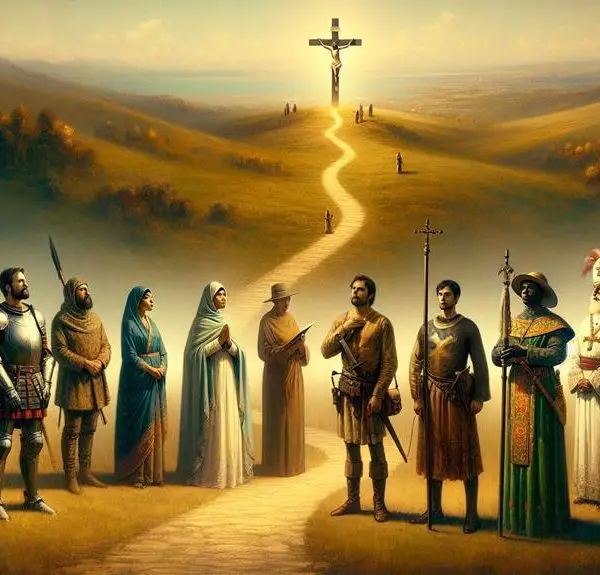
Sign up